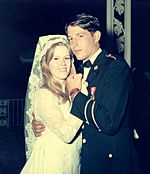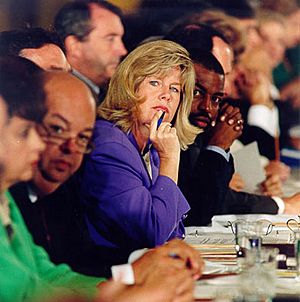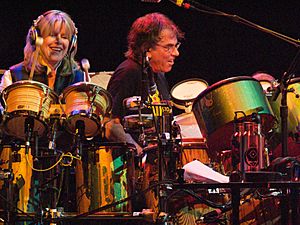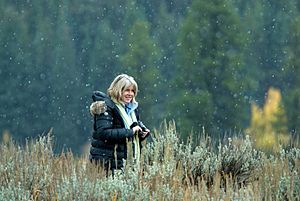Tipper Gore facts for kids
Quick facts for kids
Tipper Gore
|
|
|---|---|

Gore in 2009
|
|
| Second Lady of the United States | |
| In role January 20, 1993 – January 20, 2001 |
|
| Vice President | Al Gore |
| Preceded by | Marilyn Quayle |
| Succeeded by | Lynne Cheney |
| Personal details | |
| Born |
Mary Elizabeth Aitcheson
August 19, 1948 Washington, D.C., U.S. |
| Political party | Democratic |
| Spouse | |
| Children | 4, including Karenna and Kristin |
| Education | Garland Junior College Boston University (BA) Vanderbilt University (MA) |
Mary Elizabeth "Tipper" Gore (born August 19, 1948) is an American who has worked to raise awareness for social issues. From 1993 to 2001, she was the Second Lady of the United States. This is the title for the wife of the Vice President. Her husband at the time was Al Gore. They separated in 2010.
In 1985, Tipper Gore helped create a group called the Parents Music Resource Center (PMRC). The group wanted music with adult themes to have warning labels on the album covers. This was especially for genres like heavy metal, punk rock, and hip hop.
Throughout her life, she has worked to support mental health awareness, women's and children's causes, LGBT rights, and helping the homeless.
Contents
Early Life and School
Mary Elizabeth Aitcheson was born in Washington, D.C.. Her mother gave her the nickname "Tipper" from a lullaby. After her parents divorced, she was raised by her mother and grandmother in Arlington, Virginia.
She went to St. Agnes, a private school in Alexandria, Virginia. She was very active in sports, playing basketball, softball, and field hockey. She also played the drums in an all-girl band called The Wildcats.
In 1965, she met Al Gore at his senior prom. They started dating soon after. When Al went to Harvard University, Tipper attended Garland Junior College and later Boston University. She earned a degree in psychology in 1970. That same year, on May 19, she and Al Gore got married.
Later, she earned a master's degree in psychology from Vanderbilt University in 1975.
Career and Activism
After college, Tipper Gore worked as a newspaper photographer for The Tennessean in Nashville. When her husband was elected to the U.S. Congress in 1976, she continued to work as a freelance photographer.
Gore was very involved in her husband's political career, starting with his first campaign in 1976. She also started a group called the Congressional Wives Task Force to study social problems. In 1984, she began volunteering at homeless shelters and later started a group called Families for the Homeless to help people without homes.
The Parents Music Resource Center (PMRC)
In 1985, Tipper Gore and three other politicians' wives started the Parents Music Resource Center (PMRC). She was inspired to create the group after hearing her 11-year-old daughter listening to a song by Prince with lyrics she felt were not for children.
The PMRC's goal was to make parents more aware of music with explicit, or adult, content. They suggested a voluntary system where record companies would put Parental Advisory stickers on albums.
Some famous musicians, like Frank Zappa and Dee Snider from the band Twisted Sister, disagreed with the PMRC. They argued that putting labels on music was a form of censorship, which means limiting what artists can say or create. Snider was upset when the PMRC suggested his song "Under the Blade" was about something violent, when he said it was actually about having surgery.
Gore said she was not trying to censor music. She explained that she believed in the First Amendment, which protects free speech. She said she just wanted to give parents more information. In the end, the PMRC's efforts led to the music industry agreeing to voluntarily use the "Parental Advisory" labels that are still seen today.
Work as Second Lady and Beyond
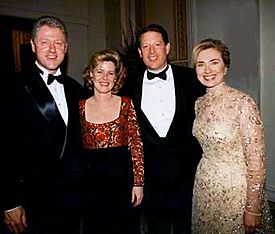
When Al Gore became Vice President in 1993, Tipper Gore became the Second Lady. In this role, she advised the president on mental health issues. She wanted to reduce the negative stigma (unfair and negative beliefs) about mental illness and make mental health care more available to everyone. In 1999, she hosted the first White House Conference on Mental Health.
She often spoke about her own struggles with depression after her son, Albert, was in a serious accident. Her goal was to show people that it is okay to seek help for mental health.
Besides her work in mental health, she was also involved in other causes. She was the spokesperson for the "Back to Sleep" campaign, which helped raise awareness about SIDS. She also took trips to other countries to help people in need. In 1994, she visited a refugee camp in Zaire to help after the Rwandan genocide. In 1998, she went to Honduras to volunteer after Hurricane Mitch.
After her time as Second Lady, Gore continued her activism. She has been a strong supporter of the LGBT community for many years. In 2008, she publicly opposed a law in California that would have banned same-sex marriage. She has also used her photography to raise money for charities that help the LGBT and HIV/AIDS communities.
Creative Talents
Tipper Gore has always loved music. In high school, she was the drummer for the band The Wildcats. She has even performed with famous musicians. She once played drums with members of the rock band the Grateful Dead and with country singer Willie Nelson.
She is also a talented photographer. She has published several books of her photos, and her work has been shown in art galleries.
Personal Life
Tipper and Al Gore have four children: Karenna, Kristin, Sarah, and Albert III. They also have several grandchildren.
In June 2010, the Gores announced that they were separating. They said it was a mutual decision they made together after a lot of thought. They remain friendly and still spend holidays and vacations together with their family.
See also
 In Spanish: Tipper Gore para niños
In Spanish: Tipper Gore para niños


